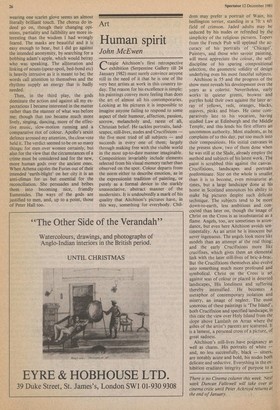Human spirit
John McEwen
Craigie Aitchison's first retrospective exhibition (Serpentine Gallery till 24 January 1982) must surely convince anyone still in the need of it that he is one of the very best artists at work in this country today. The reason for his excellence is simple: his paintings convey more feeling than does the art of almost all his contemporaries. Looking at his pictures it is impossible to imagine anyone failing to respond to some aspect of their humour, affection, passion, sorrow, melancholy and, rarest of all, Christian belief. He tackles portraits, landscapes, still-lives, nudes and Crucifixions — the five most tried of all subjects — and succeeds in every one of them; largely through making free with the visible world in the most up-to-date manner imaginable. Compositions invariably include elements selected from his visual memory rather than observed on the spot. Colour departs from the norm either to describe emotion, as in the expressionist tradition of painting, or purely as a formal device in the starkly unassociative, abstract manner of the modernists. It is undoubtedly a mark of his quality that Aitchison's pictures have, in this way, something for everybody. Chil dren may prefer a portrait of Wain, his bedlington terrier, standing in a 7ft x oft field of crimson. Jaded adults may be seduced by his nudes or refreshed by the simplicity of the religious pictures. Topers from the French Pub will applaud the accuracy of his portraits of 'Chicago'. Painters, and those who savour painting, will most appreciate the colour, the selfdiscipline of his sparing compositional selection, the geometric solidity of design underlying even his most fanciful subjects.
Aitchison is 55 and the progress of the show most reveals his development over the years as a colorist. Nevertheless, early works in quieter greens, browns and purples hold their own against the later array of yellows, reds, oranges, blacks, mauves, pinks and blues. He came comparatively late to his vocation, having studied Law at Edinburgh and the Middle Temple, and this lends his first efforts an uncommon authority. Most students, as he complains of to this day, put too much into their compositions. His initial canvases in the present show, two of them done when he was still at the Slade, already employ the method and subjects of his latest work. The paint is scrubbed thin against the canvas. Crucifixions, landscapes and portraits predominate. Size on the whole is smaller than it is to become, even miniaturist at times, but a large landscape done at his home in Scotland announces his ability to make big pictures despite such delicate technique. The subjects tend to be more down-to-earth, less ambitious and concocted than later on, though the image of Christ on the Cross is as insubstantial as a flame. Angels, too, are sometimes in attendance, but even here Aitchison avoids sentimentality. As an artist he is innocent but never ingenuous. The angels look more like models than an attempt at the real thing; and the early Crucifixions more like crucifixes, which gives them an elemental link with the later still-lives of bric-a-brac. But the Crucifixions themselves also evolve into something much more profound and symbolical. Christ on the Cross is set against seas of colour or placed in deserted landscapes, His loneliness and suffering thereby intensified. He becomes a metaphor of contemporary isolation and misery, an image of neglect. The most sonorous of these paintings is 'The Island', both Crucifixion and specified landscape, in this case the view over Holy Island from the slope above Lamlash on Arran where the ashes of the artist's parents are scattered. It is a lament, a personal cross of a picture, of great sadness.
Aitchison's still-lives have poignancy as well as charm. His portraits of white — and, no less successfully, black — sitters, are notably acute and bold, his nudes both delicate and seductive. Everything in the exhibition eradiates integrity of purpose to a degree that makes his extension into religious painting entirely logical. It gives his work a positive spiritual quality that is both very rare and very valuable as an artistic attribute at any time. Some years ago there was a show in London called The Human Clay. 'But where's the human spirit?' commented one of its most distinguished visitors. It resides, more than a fair porportion of it, in the art of Craigie Aitchison.
A small exhibition of Aitchison paintings of various dates is on view at the 12 Duke Street Gallery (till 15 January 1982). Its excellence is a reminder that the Serpentine displays only 85 works out of a life total of over 300. Upstairs there are some drawings and two sculptures by the Spanish 20th century master, Julio Gonzalez. He was doing things in the Thirties that British sculptors got around to in the Fifties.







































 Previous page
Previous page